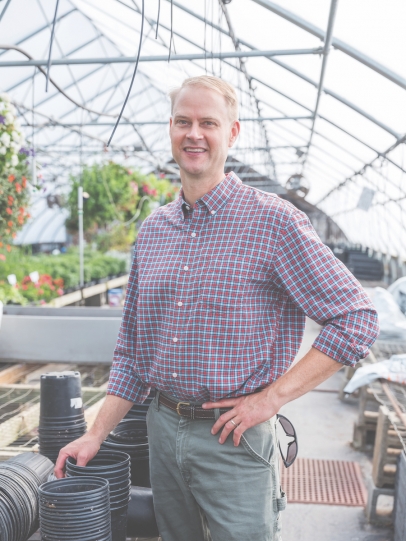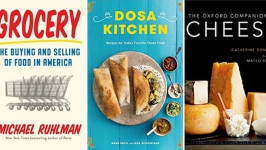David Haight: Saying Yes to Farms, Yes to Food
Since 1992, New York State has lost nearly half a million acres of farmland to subdivisions, strip malls and other development. Fortunately, Saratoga-based American Farmland Trust is taking definitive measures to permanently protect our present farms and watersheds from the same fate. But as David Haight, New York State’s director of American Farmland Trust, notes, “For every farm we’ve protected, probably 10 others have been paved over. We have our work cut out for us.”
Let’s get right to the point. What are the most pressing challenges facing our farmers and their land?
Five thousand farms in New York have been paved over since the early 1980s. The threat of real estate development is a major concern. A full 30% of our farmers are age 65 or older, and they’re managing about two million acres of land. More than 90% of those older farmers don’t have a younger person involved in the management or ownership of their farm. What happens to that land in the coming 10 years is uncertain. Therefore succession planning and helping farmers to transition their land is of crucial importance. We cannot take our farmers or our farmlands for granted.
So how does AFT help?
Through AFT, New York was one of the first states to permanently protect farmland. Our mission is threefold: Save the land that sustains us by protecting farmland, promoting sound farming practices and keeping farmers on the land. In other words, don’t pave it over, make sure it’s well cared for, and make sure farmers can make a living on it.
We lead a coalition called the Alliance for New York’s Farmland, and we’re the leading voice calling out for the need for public investment to protect farmland. We partner with about 25 land trusts and other stakeholders around the state and raise money to protect the land. Our partnerships throughout the Hudson River corridor have helped 144 farmers find land in this region in the last four years.
We’re also very involved in thinking about climate change, recognizing that farmland is a valuable asset in sequestering carbon. State data reveals that the average acre of farmland in New York produces 66 times fewer greenhouse gas emissions than an acre of developed land. That’s a compelling reason to keep our farms productive, intact and protected from development. Farmland can help address some of the biggest environmental challenges facing our society.
Describe your roots as an environmentalist.
I grew up in the North Country, in Peru, a stone’s throw from the Adirondack Park, with apple orchards bordering our home on two sides. My playground was this majestic six-million-acre experiment of public-private land, an incredible environmental success story. But I was always interested in the people side of environmental issues, how they connect with the land and find ways to make a living from it.
How did you land at AFT?
My early interests were forestry and forest policy. After graduating from Binghamton, I studied land conservation and tax policy at the University of Vermont. An opportunity opened here with American Farmland Trust in Saratoga, so I started in 2001 as their Northeast field rep. My territory covered from Bangor, Maine, to Buffalo.
While living here in Saratoga, I was a regular at the farmers’ market. I met a beautiful woman named Suzanne Balet who was selling flowers, and for about two years, I bought a lot of flowers. Suzanne and I got married and we have a small flower farm, Balet Flowers and Design, a couple miles from the race track. She’s the farmer in the family, not me. Suzanne grew up on a farm just north of Saratoga. Her parents, in fact, were one of the first farms to open the Saratoga Farmers’ Market. She’s been coming to the market since she was eight, the cute blonde girl selling lemonade while her parents sold vegetables out of the back of their old Ford truck.
Tell me about some Capital Region success stories.
It’s particularly compelling for me when we permanently protect farms for agricultural use. When I started, that was a relatively new concept. Now, thanks to collaborative efforts, farmland protection is becoming more commonplace. An amazing example is Zack and Annie Metzger of Laughing Earth Farm. They’re new-generation farmers who run a dynamic vegetable and livestock farm in Brunswick. They were able to work with local land trusts, tap into some state funds, get a farm protected and purchase it from a couple of retiring farmers. Twenty years ago that wouldn’t have been possible. We didn’t have the money or the speed to react that quickly.
Another good story is Jessica and Stewart Ziehm, who successfully transitioned their family’s dairy farm in Easton. We collaborated with the local land trust, the Agricultural Stewardship Association of Greenwich, to help Stewart and his brothers protect the home farm and subsequently purchase a second farm, without incurring crushing debt.
What else is on your radar?
We’re exploring how to create more markets for farmers. New York has a strong Farm to Institution initiative, and we are actively encouraging institutions to invest a portion of their budgets on locally grown products. State-funded institutions like public schools, SUNY colleges, hospitals, prisons, daycare or senior centers, all of which feed 6.6 million people annually. They spend approximately $950 million on food each year. Imagine if they dedicated 25% of those allotted funds to New York–grown products? That would have a tremendous impact on our farmers, and on the health of the consumers! We see this as a real opportunity to drive new food dollars into our backyard. The best way to help sustain our farmers is to be more intentional with our food dollars.
We also coordinate a coalition called New York Grown Food for New York Kids. The last New York State budget doubled the funding for farm-to-school programs and created the first of its kind incentive for schools to buy New York–grown food. That helps educate kids about where their food comes from, and again, it’s another strategy to help keep our farmers on their land.
How have you seen the region’s agricultural scene evolve since you started in 2001?
Now there’s more choices—more farmers’ markets, more CSAs, more farm-based experiences and of course an explosion of farm-based breweries, distilleries and cideries. Consumers can connect with farms in ways that didn’t exist in 2000. People have a far greater understanding of why farms matter.
Looking to the future, what inspires you?
We have tremendous long-term opportunities in the Capital Region. We have the essential ingredients: fertile land, clean water and thriving metropolitan food markets within two to three hours. All those people need to be fed, so our geographic location offers real opportunity for the future. We also have a dynamic population of farmers with serious entrepreneurial spirit, people who are thinking beyond the local farmers’ markets. And we have collaborative land trusts and local, state and federal officials who understand the value of farms and support the Farm Bill.
What can we, as residents of the Capital Region, do to support the efforts of AFT?
Be intentional about your food dollars and keep your money in your backyard. Become a member of AFT. Put our “No Farms, No Food” bumper sticker on your car or tractor! That four-word ambassador message reminds everyone, especially our public leaders, that we can’t take our farms for granted.
Now on to the fun stuff! What’s an ideal weekend hold?
Suzanne has the Saratoga market on Saturdays, so we come home with a stash of great food. We’ll invite some friends over, hang out on the back screened porch, have a few drinks and do some grilling. Or if someone covers her market booth, we head to our little camp on a lake in the Adirondacks.
Describe yourself as a cook.
Like most farmers, Suzanne works 70 to 80 hours a week, so I do most of the cooking. I keep the basics on hand and create meals on the fly, using whatever inspires me. I grill meats, veggies and pizzas year-round. We also cook in cast iron on the grill as well—omelets, biscuits, rolls, beer can chicken.
How do you stock your pantry/fridge/freezer?
One of the benefits of this job is that I get to visit farms that are growing great stuff, so we have a chest freezer filled with frozen berries and local meats. Relatives are deer hunters so we benefit from that as well. Suzanne grows herbs and we have laying hens. Local cheeses make life worth living. We also eat a ton of apples and cider. And of course, excellent craft beer.
Five Rapid Fire
Breakfast today?
Greek yogurt, blueberries and peaches.
Favorite childhood meal?
Thanksgiving dinner with all the fixings followed by apple pie.
Cake, pie or cookies?
Any fruit pie.
Guilty indulgence?
Really good ice cream, with high butterfat. But should I really feel guilty??
Late-night snack?
Empire apples and natural peanut butter.
American Farmland Trust | @americanfarmlandtrust
Balet Flowers and Design
Saratoga Farmers’ Market | @saratogafarmersmarket
Laughing Earth Farm
Agricultural Stewardship Association
Farm to Institution | @farm2inst
New York Grown Food for New York Kids







